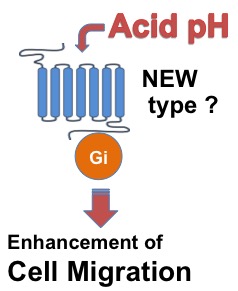An C(Inner Mongolia Medical Univ.), Wu T, Bao M, Bao L, Damirin A (Inner Mongolia Univ.), Sato K, Tobo M (IMCR, Gunma Univ.)
About
The elucidation of the functional mechanisms of extracellular acidification stimulating intracellular signaling pathway is of great importance for developing new targets of treatment for solid tumors, and inflammatory disorders characterized by extracellular acidification. In the present study, we focus on the regulation of extracellular acidification on intracellular signaling pathways in mouse embryo fibroblasts (MEFs). We found extracellular acidification was at least partly involved in stimulating p38MAPK pathway through PTX-sensitive behavior to enhance cell migration in the presence or absence of platelet-derived growth factor (PDGF). Statistical analysis showed that the actions of extracellular acidic pH and PDGF on inducing enhancement of cell migration were not an additive effect. However, we also found extracellular acidic pH did inhibit the viability and proliferation of MEFs, suggesting that extracellular acidification stimulates cell migration probably through proton-sensing mechanisms within MEFs. Using OGR1-, GPR4-, and TDAG8-gene knock out technology, and real-time qPCR, we found known proton-sensing G protein-coupled receptors (GPCRs), transient receptor potential vanilloid subtype 1 (TRPV1), and acid-sensing ion channels (ASICs) were unlikely to be involved in the regulation of acidification on cell migration. In conclusion, our present study validates that extracellular acidification stimulates chemotactic migration of MEFs through activation of p38MAPK with a PTX-sensitive mechanism either by itself, or synergistically with PDGF, which was not regulated by the known proton-sensing GPCRs, TRPV1, or ASICs. Our results suggested that others proton-sensing GPCRs or ion channels might exist in MEFs, which mediates cell migration induced by extracellular acidification in the presence or absence of PDGF.
Paper information
Extracellular acidification synergizes with PDGF to stimulate migration of mouse embryo fibroblasts through activation of p38MAPK with a PTX-sensitive manner.
An C, Sato K, Wu T, Bao M, Bao L, Tobo M, Damirin A
Biochem Biophys Res Commun. 460: 191-197, 2015
Online URL
http://www.ncbi.nlm.nih.gov/pubmed/25769958








